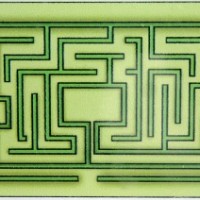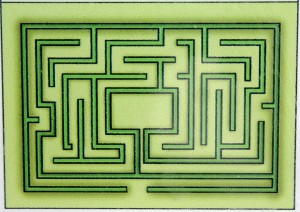

Photo by John Wesley Barker
I’m sure you can relate to reviewing the course in your mind right before entering the ring just to have it disappear at some point during the run. For the culprit, look no further than the limited capacity of your grey matter. Our brains can only work with so much information before stuff gets dropped and this requires focus and concentration.
There are certain sources of information we need to pay attention to so that we can successfully run a course. Here’s a (hypothetical?) conversation between me and my brain as I get ready to run.
Me: Piffle! That’s plenty. That’s all everybody has to spend. And I’ve seen lots of those good handlers run this course clean.
Me: That’s a problem. Okay, lets start spending. We’ll need some of those front crosses, and definitely some threadles.
Me: Yeah, that’s true. We should throw in some footwork and serps too. They could come in handy.
Me: Ok. We also need to buy that cool new arousal control stuff. It helps you keep your cool even when all your friends are watching. Hey look, some of that dog connection all those agility gurus keep talking about on their blogs. We definitely need that.
Me: Really? Already?
Me: Wow hey look. I can return some of the front crosses and half the course map and save $45 AD. Perfect. Let’s go.
Me: Naw, that’s why they number the obstacles. We can just figure it out when we get there.
Me: Forget it let’s go. Trust me. We have everything we need!
Clearly, this run didn’t go well. I could have kept the whole course map and returned something else but it always comes at a cost. I may have known where to go but, something else would have been sacrificed.
So how do those “good” agility handler’s buy the whole course map and all the other stuff they need for a great run. It’s simple. The Awesome Agility Runs Store has a customer loyalty program. The more you buy the better the deals. By the time you’ve been a customer for ten years, you’ll be able to buy in bulk. The products are never free, but they are a fraction of their original cost.
What these programs do is allow you to group things together and buy at a lower price (e.g., 3 for the price of 1). I want to give you a very powerful example of how we get to buy in bulk using the “customer loyalty program”. Grab a piece of paper and a pen and watch the video below.
In this example, when the individual letters were placed randomly, it was difficult to remember all of them in such a short time because there was no meaning in their order or structure. We don’t practice (i.e., take part in the customer loyalty program) using letters that way. When there was meaning given to the order of the individual letters, it was very easy to recall each and every letter. We practice using letters that way all the time. We are platinum members of that customer loyalty program.
The same thing happens when we are memorizing a course map. The more time you spend memorizing course maps, the more your brain will associate meaning or structure with the obstacles and begin grouping them together. Through practice we are able to link individual letters into words. Through practice we are able to link individual obstacles into sequences.
Here are a few things you can do to improve your ability to recall the courses you run. Or, how to become a card carrying member of the Awesome Agility Runs Store Customer Loyalty Program.
- Spend some training time just memorizing course maps.
- Visualize each course.
- Name common obstacle sequences.
- Push your brain in practice.
Don’t stop there though. Test yourself. Give yourself 1 minute to memorize and then recall them by drawing them on a blank sheet. Track your progress.
Sometimes at larger events you can confuse the different courses since you walk them one right after the other but then run them hours later. This can also happen at smaller trials where the courses are nested. Use visualization to keep them sorted out. See yourself doing each course on its own.
Giving names to sequences can help consolidate obstacles into a meaningful group. There are already names given to some sequences (e.g., pinwheel) by the agility community at large, but there are many other common sequences that you see all the time that don’t have names. Label them.
Use longer sequences and full courses more often in practice. Limit yourself to 1 or two looks at the map and then go for it. This includes course setting. If you plan on running two or three sequences in a training session. Look at the maps at the start of training but build them from your memory.
If you’re up for it, feel free to share your experiences with getting lost on course in the comments. In the meantime, have some fun in practice and spend some time memorizing courses, membership in this loyalty program has it’s privileges.
Leave A Reply (7 comments so far)
The comments are closed.
Linda
14 years ago
Great post especially for those who have trouble remembering courses. Visualization works well for me.
Betsy
14 years ago
Getting lost on a course WAS a real problem for me. Once it started happening it seemed as if I expected it to happen, worried about it, and made it more of a problem. I signed up for some private agility lessons and talked with the instructor about it. At the next lesson she had a course set up with NO numbers. She walked me through the first half & left the field while I walked it to decide how to handle it. She came back walked me through the second half & left the field again. When she came back I had to run the unmarked course. This exercise showed me I could remember the courses – kinda like a book my kids once had about the little train “I think I can I think I can”. I just needed to think more positively and get over the block I had pushed myself into.
Bonnie
14 years ago
Loved how you compared it to shopping and you only have so much grey matter to spend.
It helps me when I memorize a course to remember that I only do that green tunnel(for example) once so when I come to it again I don’t go in it, I can also use this for the A frame or any other type of equipment. That is one tool I find useful.
I also have a great agility coach that gives us difficult practice sequences and about 4 minutes to walk and then we run them, she will then change the numbers and we have to run the next sequence, we have about 5 different sequences with the same obsticle lay out in one practice session, it is a great way to exercise my brain. I then go home or at work(I can’t lie) the next day and draw up the practice session again so I can practice them later.
Bonnie
Jodi Altman
14 years ago
Super post! An inovative agility trainer let me in on a good method for the way my brain works (in a non-linear way)….walk the course in chunks but from end chunks of sequences to the beginning. That way, if you do get lost, you don’t have to recall the whole 20 obstacle sequence but just the chunk you are lost in. Also, when you walk from 1-20, you tend to go over the beginning more than the end so when you get lost (n0t usually at the beginnig), you know the beginning way better than the middle or end which isn’t so helpful. Thanks so much John.
Trudie
14 years ago
Your pre-competition visualization course was great. We don’t get pre-run maps. One time I had missed the walk through, and did a great run based on the visualization I had done. Having no choice, the surprise of being able to do this was a great confidence booster.
Cindy P
14 years ago
Wow, this couldn’t be more timely for me! This past weekend I lost a double Q due to losing my place toward the end of a course where there was a loop of obstacles I’d just completed, but with a slight difference. It wasn’t that I hadn’t studied or memorized the course…my mind just went totally blank as to what was next after I went through the loop for the 2nd time. It felt kind of like suddenly losing your internet connection in the middle of something reading something really good. Things just went completely blank! I just finished 12 weeks of chemo for breast cancer and the after effects could certainly have had an affect; however, I KNEW that course! I had memorized it from different angles, visualized myself running it, watched dozens of other teams run it…but had not done everything you suggest, John! I especially like your suggestion to memorize the course then re-draw it on a blank sheet of paper. Believe me, extra paper is going in my training bag NOW. Pushing my brain in practice is another great idea too. Thanks again for your wonderful insight to the mental aspects of training for dog agility – LOVE IT!
Shirley Holmes
14 years ago
Will take this up from Today. (Friday) and I am sure that I will be able to report back with a more positive attitude than what I have now.
My little Border Collie is so fast that I cant think fast enough for her. One loose movement of my arms, head or shoulders and she is gone. Mean while I have got myself in a tizz.